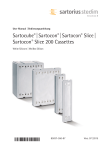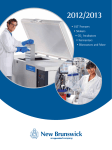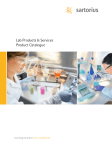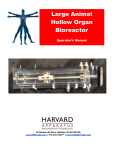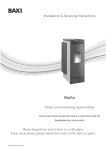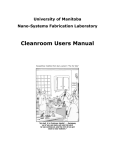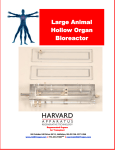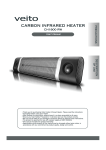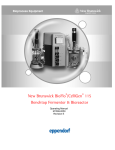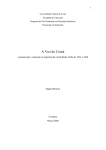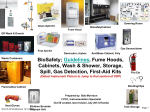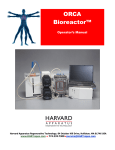Download Bioprocessing: Fermentors(New Brunswick), Description
Transcript
New Brunswick Fermentor BioFlo 110 x 3 Units @ BRDG Crossflow Satorius-Stedim @ BRDG New Brunswick Fermentor BioFlo 115 x 2 Units @ BRDG Bioprocessing Systems (Detect Instrument Picture to Jump to that section of SOP) Tubing Info Link to SERVICE/REPAIR INFO Karl Fischer titration STLCC-CPLS;Morrison 4/11/2014 Prepared by: Bob Morrison STLCC- Instrumentation Specialist Original Oct 08, Latest revision Feb 2013 ThermoFex Chillerfor Bio Vessels Gas Tanks& Supplier Page 1 Bioprocessing: BioFlow115, New Brunswick Note: If GFI or power circuit blows, check to see if rotor or blades are jammed in vessel. BioFlo 115, PN M1369-5111 B115BG400336 2/3/12 RGM Received to R119 Registered NBSC website 2/9/12 BioFlo 115, PN M1369-5120 B115BG800337 2/3/12 RGM Received to R119 Registered NBSC website 2/9/12 With 1.3L and 14.0L Vessels Hot Link to New Brunswick BioFlo 115 Operations Manual … pdf Hot Link to New Brunswick BioFlo115 Brochure … pdf Hot Link to New Brunswick BioFlo115 Brochure, Parts, and Desc.… pdf STLCC-CPLS;Morrison 4/11/2014 Grow virtually any cell type: aerobic and anaerobic microbes, yeast, insect, plant and mammalian cells. Water-jacketed and heat-blanketed autoclavable glass vessels are offered in four sizes, 1.3, 3.0, 7.5 and 14.0 Liters (total volume). All 115 systems are pre-programmed with both fermentation and cell culture operating modes for total flexibility. Switching between modes automatically adjusts gas flow and speed ranges. A wide variety of options and accessories provide the versatility for customization to your exact needs. Choose from eight vessels, three motor drives, specialized impellers, up to four Rotameters with multiple gas flow ranges, a Thermal Mass Flow Controller (TMFC), and more. Page 2 Bioprocessing: BioFlow 115 Gas Connections STLCC-CPLS;Morrison 4/11/2014 Page 3 Bioprocessing: BioFlo115, Cabinet Controls, Touchscreen STLCC-CPLS;Morrison 4/11/2014 Page 4 Bioprocessing: BioFlo115, Screen Summary, ex STLCC-CPLS;Morrison 4/11/2014 Page 5 Bioprocessing: BioFlo115, Ex: Cell culture without Thermal mass flow control STLCC-CPLS;Morrison 4/11/2014 Page 6 Bioprocessing: BioFlo 115, Notes on Calibrating pH Probe (Ian R. 8/1/12) • Note: pH probe should always be stored wet, never allow to dry. Do not store in DI water. Recommend 7.0 buffer. • Go to BioFlo Calibration screen from bottom of main menu • Rinse probe with DI, put in 7.0 solution, wait for Raw Data display to settle down, can be 10min or more. When it does, push “Set Zero” to lock in value. Note screen will go back to blank after this is set • Rinse probe with DI, put in 4.0 solution, wait again for Raw Data value to settle, then hit “Set Span” button to lock in value. • Return pH probe to storage solution or immediately Autoclave for use. – Experience has not indicated a recalibration is required after Autoclave STLCC-CPLS;Morrison 4/11/2014 Page 7 Bioprocessing: BioFlo 115, Notes on DO Probe (per Ian R. 8/1/12) • In past experience has not calibrated DO probe • Manual says DO probe must be connected to the controller at least 6 hours before use STLCC-CPLS;Morrison 4/11/2014 Page 8 Bioprocessing: BioFlo 115, Notes on Air Feed (per Ian R. 8/11/12) • If Lab air (87 psi) is available/nearby, it must be routed through a regulator to drop pressure to the 10-12 psi range before connecting to a Bioflo controller and/or the vessel • A peristaltic pump with tubing is generally recommended vs. lab air and can be connected directly to the vessel via any available headplate port. Always install a filter on the inlet side of the tubing to avoid contamination. STLCC-CPLS;Morrison 4/11/2014 Page 9 Bioprocessing: BioFlo 115, Notes on Sampling (per Ian R. 8/16/12) • Sanitize hand/gloves, remove foil on the end of the sampling tube, sanitize luerlock port • Using sterile syringe, extract nominal amount of media via luerlock port on sampling tube, discard this media as it would be in the extraction pipeline and possibly not all from vessel volume. • Using a fresh sterile syringe, extract desired amount of media • Test in Spectrophotometer for optical density STLCC-CPLS;Morrison 4/11/2014 Page 10 Bioprocessing: BioFlo115, Accessories, Parts 1/2 STLCC-CPLS;Morrison 4/11/2014 Page 11 Bioprocessing: BioFlo115, Accessories, Parts 2/2 STLCC-CPLS;Morrison 4/11/2014 Page 12 Bioprocessing: Fermentor, New Brunswich BioFlo 110 (@BRDG) Note: If GFI or power circuit blows, check to see if rotor or blades are jammed in vessel. STLCC-CPLS;Morrison 4/11/2014 Page 13 Bioprocessing: Fermentor, BioFlo110 , Manuals & Information Hot Link to New Brunswick BioFlo 110 Operations Manual … pdf (3mb) Hot Link to Overview Pichia processing … pdf Hot Link to Paper on Pichia Protocol … pdf Hot Link to Paper on Anaerobic Yeast Ethanol … pdf Hot Link to New Brunswick BioFlo115 Brochure … pdf Hot Link to New Brunswick BioFlo115 Brochure, Parts, and Desc.… pdf STLCC-CPLS;Morrison 4/11/2014 Page 14 Bioprocessing: Fementors; Typical Bioflo 110 Setup Rotameter (Air Supply/Return) STLCC-CPLS;Morrison 4/11/2014 Page 15 Bioprocessing: Fermentors; Bioflo 110 Vessel Components Note: If GFI or power circuit blows, check to see if rotor or blades are jammed in vessel. STLCC-CPLS;Morrison 4/11/2014 Page 16 Bioprocessing: Fermentor; 7.5 and 14.L Headplate Definition STLCC-CPLS;Morrison 4/11/2014 Page 17 Bioprocessing: 1.3L Headplate configuration STLCC-CPLS;Morrison 4/11/2014 Page 18 Bioprocessing: Rotameter on Air Supply Max flow rate Fermentation= 11.4 Lpm, Cell Culture 2.5 Lpm STLCC-CPLS;Morrison 4/11/2014 Page 19 Bioprocessing: Probes and Tubes Temp probe Solid Note: Take extreme care not to bend any hollow tubes. If only slightly bent, ferrules and other attachment fittings cannot be moved and the entire tube may need to be replaced. Harvest or Sample Tube Innoculation Tube Sparger; with small holes STLCC-CPLS;Morrison 4/11/2014 Page 20 Bioprocessing: dO2 and pH Probe Assembly Fill with squeeze bottle solution if required. Note some models are permanently gel -filled Calibration: Ph 7, Set Zero, wait until counts stabilize, then enter value, then return key X to get back to next setting. Bottom Ferrule Email to Mettler-Toledo for Quote on pH probe: 405-DPAS-SC-K8S/325 [email protected] STLCC-CPLS;Morrison 4/11/2014 Page 21 Bioprocessing: pH Probe 1.3L , Mettler, Unpacking STLCC-CPLS;Morrison 4/11/2014 Page 22 Bioprocessing: DO Probe Kit 1.3L, Adapter Assembly Details STLCC-CPLS;Morrison 4/11/2014 Page 23 Bioprocessing: Headplate, Adapter, Adjustable 12mm (required for pH, DO, Condenser) STLCC-CPLS;Morrison 4/11/2014 Page 24 Bioprocessing: Exhaust Condenser Details STLCC-CPLS;Morrison 4/11/2014 Page 25 Bioprocessing: Exhaust Condenser, Bill of Materials STLCC-CPLS;Morrison 4/11/2014 Page 26 Bioprocessing: Exhaust Condenser and Solenoid Valve Connections Connect to cool water supply line that by-passes the solenoid valve used for the cooling coil or water jacket. Connect to cooling coil or water jacket. STLCC-CPLS;Morrison 4/11/2014 Page 27 Bioprocessing: Sampler System Ordering Sampling Kit: New Brunswick/Eppendorf M2373-9953 102 Motor Parkway Hauppauge NY 11788 Tel 516-334-7500 STLCC-CPLS;Morrison 4/11/2014 Note: Take extreme care not to bend any hollow tubes. If only slightly bent, ferrules and other attachment fittings cannot be moved and the entire tube may need to be replaced. Page 28 Bioprocessing: 1.3L Sampler/Harvesting STLCC-CPLS;Morrison 4/11/2014 Page 29 Bioprocessing: Foam Trap STLCC-CPLS;Morrison 4/11/2014 Page 30 Bioprocessing: BioFlo115; Sparge Connections STLCC-CPLS;Morrison 4/11/2014 Page 31 Bioprocessing: Lab Air, Bench Valve and Regulator 1. Locate AIR valve and regulator behind the NB controller #8 stack (closest to whiteboard) 2. Make sure main chrome valve is open (in –line) position. 3. Turn black axial valve behind gage clockwise to open and increase pressure to desired level (10-15 psi) STLCC-CPLS;Morrison 4/11/2014 Rear of Controller # 8 stack Page 32 Bioprocessing: Autoclaving, Objectives and Methods STLCC-CPLS;Morrison 4/11/2014 Page 33 Bioprocessing: Autoclave, Initial Steps with Hardware STLCC-CPLS;Morrison 4/11/2014 Page 34 Bioprocessing: Autoclaving, Media Notes STLCC-CPLS;Morrison 4/11/2014 Page 35 Bioprocessing: Vessel Autoclaving, Liquids Cycle 253C Wrap all filter ends with aluminum foil to protect from steam and condensation Add 1-2L liquid to cover pH and DO probes and orient vessel on cradle to cover the ends of the probes. Make sure the vessel is vented to avoid overpressure and potential cracking of the vesel. STLCC-CPLS;Morrison 4/11/2014 Page 36 Bioprocessing: Service/Repair, Training Info pH Probe: Email to Mettler-Toledo for Quote on pH probe: 405-DPAS-SC-K8S/325 [email protected] Other Probes or New Brunswick items: Get Part number from Manual , send to Teri Hacker Chiller: Thermo-Sci, Get quote from Fisher Scientific Bioprocessing Training: Nov 10 to BS, BM by: Toby Mapes ([email protected]) Tubing Order Info PO to Cole-Palmer per TH 1/20/11 STLCC-CPLS;Morrison 4/11/2014 Page 37 Bioprocessing: Tubing, MasterFlex, Sizes STLCC-CPLS;Morrison 4/11/2014 Page 38 Bioprocessing: Tubing, Chemical Compatibilility STLCC-CPLS;Morrison 4/11/2014 Page 39 Bioprocessing: Tubing, Features/Contraints pg 1/2 STLCC-CPLS;Morrison 4/11/2014 Page 40 Bioprocessing: Tubing, Features/Contraints pg 2/2 STLCC-CPLS;Morrison 4/11/2014 Page 41 Bioprocessing: Gases, Flashback Arrestor, Airgas supplier From Airgas STL: PN Y33-1FA44 Manf: SuperFlash Model: DGN, Fuel, ¼” NPT Flashback Arrestor for Regulators and Point of Supply. Model DGN flashback arrestors can easily be installed on the outlet fitting of most regulators and gas supply points. They help meet ANSI Z49.1:2005, OSHA, and NFPA safety requirements and help protect against the most common causes of accidents such as reverse gas flow, flashback, and hose burn backs. Each DGN is 100% tested with actual flashbacks and have built in 100 micron inlet filters, reverse flow check valves, flame barriers, and thermal cut-off. Inlet: G-3/8" Female LH x Outlet: G-3/8" Male LH, Fuel Gas Service Model: DGN STLCC-CPLS;Morrison 4/11/2014 Page 42 Bioprocessing: Notes from Fall2010 Class Instructors These new swabable luer valves were developed as substitutes for needle ports in IV applications. They are designed to fill, hold and release controlled amounts of fluids on demand. Needless access sites are designed for drug delivery/I.V. therapy applications as replacements for needle access ports. The valve stem and body will mate securely with all standard luer syringes and luer connectors. All materials are Gamma resistant, USP Class VI, latex free and DEHP free. Bodies are available in polycarbonate or in PVC for easy bonding. The stems are produced from silicone. The valves are compatible with American National Standards for medical material, luer taper fitting ISO 594, ANSI/HIMA MD 70.1-83, EN20594 and BS 5081, 176. The series 245000xxx is a swabable valve utilizing a female luer lock connector and a male luer lock adapter. The series 245600xxx is a swabable valve utilizing a female luer lock connector and an inline "Y" adapter. Halkey-Roberts Corporation, An Atrion Company, 11600 9th St. N., St. Petersburg, FL 33716. Tel: 727-577-1300; Fax: 727-578-0450. Bob, 12/10/2010 Here is the bioprocessing ideas that Dennis Cooley threw out at me last Wednesday. I’m just passing on his ideas…valid or not….for future use. *It looks like the filter off the condenser was somehow getting clogged, and was not passing air afterward. His suggestion was to run tubing from the condenser to a catch vessel, and then use a filter on the catch vessel. * He thought that maybe the condenser didn’t work very efficiently at higher temperatures, so maybe that is why the cooler was ran at lower temperatures. (Which brought on more “sweating”…) *For any future mammalian cell culture runs, he suggested using the sparge RING instead of the STONE to inject the air/CO2 (I don’t remember which) into the vessel. B. There is a company of the manual used forthe class in another email. Now stored in Protocols Directory on Pdrive. By BobM 12/12/10 STLCC-CPLS;Morrison 4/11/2014 Page 43 Lab Systems: BRDG HVAC; R122, Bioprocessing, Classroom, NE Seg Supply Air In Cubic Feet per Minute Exhaust rate : 1595 + 1455 = 3050 CFM (Cubic feet/min) Room ~ 9,000 CF Complete turnover every 3 min Tri-Port Exhause Vent line Added Mar 11 to countertop Vertical line PVC to Ceiling Exhaust vent. Hotlink to Wexford BRDG Park Drawing, New Work, 1st floor, M11-201 STLCC-CPLS;Morrison 4/11/2014 Page 44 Bioprocess: Motor Power Consumption, Access for Amp Meter Mike Davies project July 2011 Access to power consumption of motor/agitator Located positive current line in control cable (per manual diagram) cut for access to Amp meter Positive Current line STLCC-CPLS;Morrison 4/11/2014 Page 45 Bioprocessing : Chiller, ThermoFlex 900, Neslab/Thermo Specifications Reservoir Volume 1.9 gal. (7.2L) Temperature Range 5° to 40°C (Ambient +10° to 40°C) Temperature Stability ±0.1°C Display LCD Order Bags from Fisher Scientific per info below.101101010000006 900w; Pumping option PD1; 115V 60Hz 1. 2. 3. On/Off toggle at top rear Push On/Off Set Temperature Hotlink to NesLab/Thermo Chiller User Manual…pdf STLCC-CPLS;Morrison 4/11/2014 Page 46 Bioprocessing: Chiller, Set Temperature Programming STLCC-CPLS;Morrison 4/11/2014 Page 47 Bioprocessing: Chiller, Reset Filters STLCC-CPLS;Morrison 4/11/2014 Page 48 Bioprocessing: Crossflow System, Satorius-Stedim Slice 200 (17525SYS-BT1) Automate, optimize and document the crossflow processes. The powerful controller of this unit provides your crossflow process with a constant feed rate or constant, predefined inlet pressure by adjsuting the speed of the peristaltic pump head. Constant Transmembranepressure is also possible. Up to five different independent alarms allow the user to stop the crossflow process automatically or to give an alarm e.g. after a predefined permeate weight signal is triggered or a maximum pressure limit is reached. All values are transferred to a Worksheet of the Sartowedge data collection software. Some visual graphs are predefined for fast process control. User defineable alarms for reliable operations On board application programs Finger-tip control via the front panel Interfaces directly to PC Optically-encoded and servo-controlled pump motor Real-time process verification and documentation FEATURES: Tandem 1082 Peristaltic Pump 500 ml Graduated PES (Polyethersulfone) Feed Vessel 316L (1.4404|1.4435) SS Sartocon Slice 200 Holder Sartorius Laboratory Balance Talent TE 4100 Medical Grade Pressure Transmitters 900 RPM Integral Stir Plate and stir bar Hot Link to Satorius Slice Brochure (parts list) ..pdf Luer Fittings, T-pieces, Valves and Vents Pinch Valve for back pressure control 6 feet of Phar Med #15 Tubing Balance and Pump RS232 Interface cables Printed manual available in Bioprocessing room Win Wedge|SartoWedge PC Software No online digital manual has been located. STLCC-CPLS;Morrison 4/11/2014 Page 49 Bioprocessing: Crossflow-Slice, Diagram STLCC-CPLS;Morrison 4/11/2014 Page 50 Bioprocessing: Filtration, Karl Fischer Donated by Denise Heinz [mailto:[email protected]] titration method in analytical chemistry that uses coulometric or volumetric titration to determine trace amounts of water in a sample. STLCC-CPLS;Morrison 4/11/2014 Page 51 Bioprocessing: Filtration, Vacuum, Examples STLCC-CPLS;Morrison 4/11/2014 Page 52 Biosafety: Clean/Bio-Safe Gowning Room Design Features EXAMPLE ( 1. Secure lockers for personal property 2. Shoe cleaner, w brushes 3. Walk-off adhesive shoe mat 4. Air Shower, HEPA loose contaminants 5. Hand washing station, no-touch operation 6. Hand dryer HEPA filtered air, no touch 7. Dispenser for glove liner or underglove 8/9. Glove washing/drying station 10. Headwear dispenser 11. Face mask dispenser 12. Waste receptacle 13. Garment Storage Facility 13a Open Rack for reusable garments 13b Enclosed Cabinet for reusable garments (includes HEPA blower) 13c Shelves for disposable garments 14. Waste Receptacle 15. Ergonomic Lean Rails support personnel while donning coveralls 16. Gowning Platform provides a noncontaminated surface to prevent violation of garment 17. Wiper dispenser—used to clean bench prior to putting on booties 18. Bootie/shoe cover dispenser (may also be incorporated into benches) 19. Waste Receptacle 20. Gowning benches, used when putting on booties. Booties stay on "clean" side 21. Cleanroom mirror for final self-inspection (side-by-side w/poster showing correctly garbed model) 22. Safety glass and overglove dispensers 23. Air shower—may be required in cleanroom entrance 24. Garment hamper for reusable garments to be laundered 25. Waste receptacle for disposable garments 26.Tools, supplies cabinet for overstock garments or cleanroom supplies STLCC-CPLS;Morrison 4/11/2014 Page 53 BioSafety: Gowning Room 120, Proposed Layout Air Shower Air Entrance Door BioTrash Shoe Cleaning Mat 45” 18 Wall Hooks for Gowns Exit Door To Lab Check Mirror BioTrash Chairs for Putting on footwear New Garment Shelf Storage Cleaning Supplies Gloves, Glasses Storage Scope & Desk w PC 61” Scope Storage STLCC-CPLS;Morrison 4/11/2014 Page 54 Bioprocessing: Facility @BRDG, R119, Looking North Lab Gas Tanks and Regulators. Lab Air: Valve and Regulator behind controller PC: FVBP119-01 Primary Controller #8 STLCC-CPLS;Morrison 4/11/2014 PC: FVBP119-02 Primary Controller #0 PC: FVBP119-03 Primary Controller #12 Page 55 Bioprocessing: Facility @BRDG,Looking NW 2 of 3 Units Shown STLCC-CPLS;Morrison 4/11/2014 Page 56 Bioprocessing: Facility @BRDG, Looking SE STLCC-CPLS;Morrison 4/11/2014 Page 57 Bioprocessing: Info; CITSen, Glucose Sensor-Receiver $58 CITSens Bio sensor is a screen-printed electrode with an immobilized enzyme and is connected with a cable to the CITSens Bio beamer. The measured data will be transmitted wireless to the receiver ZOMOFI® which is connected via RS232 or LAN to a PC. Suitable for all standard disposable reactors such as spinner flasks, roller bottles, T-flasks, hyper flasks, Erlenmeyer flasks, cell stacks, customer-specific systems, bag reactors and other SUBs (single-use-bioreactors). The sensor is fit in the corresponding original cap, subsequently gamma-sterilized and delivered to the customer ready for use. $158 The CITSens Bio beamer is a radio transmitter, which transmits the measured data from the CITSens Bio sensor glucose, lactate or glutamate to the ZOMOFI®. $6890 CITSens Bio ZOMOFI® receives data from CITSens Bio beamer which have been collected online by either CITSens Bio sensor glucose, -lactate and/or -glutamate. ZOMOFI® can receive measurement data from up to 1000 beamers and transfers them to the PC by means of RS232 or LAN. The CITSens Bio software imports the data and stores them in a database.The measured values can be processed, displayed and saved by the means of the CITSens Bio software in [g/l] und [nA]. STLCC-CPLS;Morrison 4/11/2014 Page 58 Bioprocessing: Info;YSI Glucose Monitoring/control On-Line Analysis For processes that require frequent monitoring and regulation, on-line analysis allows you the freedom to sample automatically and adjust both nutrient and byproduct concentrations. Couple the YSI 2730 Aseptic Monitoring & Control system with the 2700 SELECT and pull samples directly from a bioreactor, measure important nutrients and byproducts, and immediately control the replenishment of nutrients, if needed, while maintaining the sterility of the process. All system components are sterilizable. How On-Line Monitoring Works The YSI 2730 Monitoring and Control system pulls sample directly from a bioreactor and pumps it to the YSI 2700 SELECT at programmed intervals. After each analysis, an antiseptic reagent, typically a dilute hypochlorite or hydroxide solution, is flushed through the sample lines and remains there until the next cycle to assure sterility. For those bioprocesses in which loss of cells is a concern, you can connect the YSI system to an on-line filtration device. You can adjust system parameters, such as flow rate, to accommodate the needs of the filtration device. For regulation, connect the YSI 2700 SELECT to a feed pump. When nutrient concentration falls below a programmed setpoint, the YSI 2700 SELECT will signal the feed pump to add nutrient to the bioreactor. Other system variables, such as sampling interval and concentration setpoint, allow you to customize the instrument for your process needs. For example, with processes that consume glucose quickly, you can configure the system to monitor glucose every few minutes. For other processes that consume nutrients slowly, monitoring every 30 or 60 minutes may be more appropriate. STLCC-CPLS;Morrison 4/11/2014 Page 59 Bioprocessing: Info; Online Glucose with Finesse STLCC-CPLS;Morrison 4/11/2014 Page 60 Bioprocessing: Gas, Oxygen, OXUSP200 from Airgas STLCC-CPLS;Morrison 4/11/2014 Page 61





























































